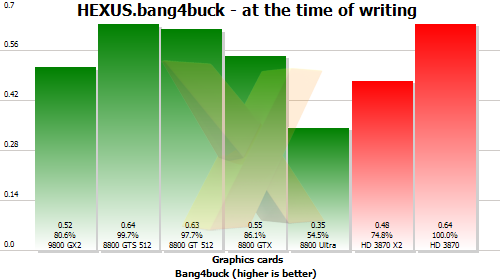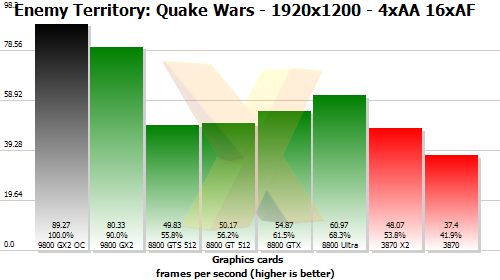HEXUS.bang4buck, power-draw, temperatures, overclocking
HEXUS.bang4buck.
In a rough-and-ready assessment of the cards' bang per buck, we've aggregated the 1,920x1,200 frame rates for the three games, normalised them* and taken account of listed the cards' prices.
But there are more provisos than we'd care to shake a stick at. We could have chosen three different games, the cards' prices could have been derived from other sources and pricing tends to fluctuate daily.
Consequently, the table and graph below highlight a metric that should
only be used as a yardstick for evaluating comparative performance with
price factored in. Other architectural benefits are not covered,
obviously.
| Graphics cards | ZOTAC GeForce 9800 GX2 1024MiB | MSI NX8800GTS-T2D512E-OC | ZOTAC GeForce 8800 GT 512MiB AMP! Edition | NVIDIA GeForce 8800 GTX 768MiB | NVIDIA GeForce 8800 Ultra 768MiB | Sapphire Radeon HD 3870 X2 1024MiB | Sapphire Radeon HD 3870 512MiB |
|---|---|---|---|---|---|---|---|
| Actual aggregate marks at 1920x1200 | 271.53 | 158.21 | 153.55 | 156.75 | 173.44 | 174.27 | 107.04 |
| Aggregate marks, normalised*, at 1920x1200 | 205.8 | 119.85 | 118.16 | 124.04 | 139.25 | 128.84 | 82.76 |
| Current price | £399 | £188 | £189 | £225 | £399 | £269 | £129 |
| HEXUS.bang4buck score at 1920x1200 | 0.516 | 0.638 | 0.625 | 0.551 | 0.349 | 0.479 | 0.642 |
| Acceptable frame rate (av. 60fps) at 1920x1200 | No (LP) | No (ET, LP) | No (ET, LP) | No (ET, LP) | No (LP) | No (ET, LP) | No (CoH, ET, LP) |
* The normalisation refers to taking playable frame rate into account. Should a card benchmark at over 60 frames per second in any one game, the extra fps count as half. Similarly, should a card benchmark lower, say at 40fps, we deduct half the difference from its average frame rate and the desired 60fps, giving it a bang4buck score of 30 marks. The minimum allowable frame rate is 20fps but that scores zero.
As an example, should a card score 120fps we treat it as 90fps as only half the frame rate above 60fps is counted for the bang4buck - this is the formula: (120-((120-60)/2)). Similarly, should it score 30fps, we count it as only 15fps: (30+((30-60)/2)).
The reasoning behind such calculation lies with playable frame rates.
Should card A score 110fps in a benchmark and card B 160, then card B would otherwise receive an extra 50 marks in our HEXUS.bang4buck assessment, even though both cards produce perfectly playable frame rates and anything above 60fps is a bonus and not a necessity for most.
Similarly, without our adjustments, the aggregated HEXUS.bang4buck total for two very different cards would be identical if, in a further benchmark, card A scored a smooth 70fps and card B an unplayable 20fps. Both would win marks totally 180, yet the games-playing experience would be vastly different.
A more realistic (and useful) assessment would say that card A is better because it ran smoothly in both games - and that view would be accurately reflected in our adjusted aggregation, where card A would receive 150 marks (85+65) and card B 100 (100+0).
In effect, we're including a desired average frame rate, in this case 60, and penalising lower performance while giving frame rates higher than 60fps only half as much credit as those up to 60fps. If this doesn't make sense or you have issue with it, please hit the HEXUS community.
Here's the HEXUS.bang4buck graph at 1,920x1,200.

The graph divides the normalised score by the price.
The ZOTAC GeForce 9800 GX2 scores well enough in the HEXUS.bang4buck analysis, and that's pleasantly surprising given its estimated £400 price-tag. Performance is such that NVIDIA partners' pricing can be justified at that level; there is nothing else to touch it with respect to single-card performance.
What the graph also shows is that one will receive more-than linear increases in normalised performance when spending the extra £130 over and above a Radeon HD 3870 X2's.Temperatures
| Graphics cards | ZOTAC GeForce 9800 GX2 1024MiB | MSI NX8800GTS-T2D512E-OC | ZOTAC GeForce 8800 GT 512MiB AMP! Edition | Sapphire Radeon HD 3870 X2 1024MiB | Sapphire Radeon HD 3870 512MiB |
|---|---|---|---|---|---|
| Ambient temperature in degrees C | 23.5 | 18.5 | 21 | 19 | 20.5 |
| Idle temperature in degrees C | 66 | 58 | 52 | 56 | 55 |
| Load temperature in degrees C | 85 | 76 | 74 | 80 | 89 |
| Ambient-to-load delta in degrees C | 61.5 | 58.5 | 53 | 61 | 68.5 |
Cooling in excess of 1.5bn transistors in a dual-slot design isn't straightforward. NVIDIA's reference card, and by extension ZOTAC's, does reasonably well, keeping the 65nm process ticking along at 85°C under load, or 20°C below the thermal threshold. The figures compare well with other high-end cards'.
Power-draw
Power-draw was measured with the systems at idle and with them running 3DMark06's Canyon test at 1,920x1,200 4xAA, 16xAF. Note, though, that the underlying platform for all power-draw testing was the ATI-based setup (bar different memory timings) that is detailed on page five.| Graphics cards | ZOTAC GeForce 9800 GX2 1024MiB | NVIDIA GeForce 8800 Ultra 768MiB | Sapphire Radeon HD 3870 X2 1024MiB |
|---|---|---|---|
| System wattage idle | 174 | 140 | 137 |
| System wattage load | 313 | 298 | 291 |
The idle wattage is highly dependent upon motherboard used. NVIDIA's HybridPower effectively cuts off the juice to the discrete card and, thus, the idle figure would be substantially lower on an nForce 780a motherboard, for example.
The ZOTAC GeForce 9800 GX2 is the thirstiest of all cards here, but that's to be expected, given the power on display.
Overclocking
The G80-based cards were notoriously poor at overclocking much past their default frequencies. G92s, however, clock much higher, due to a newer, smaller manufacturing process and behind-the-scenes tweaks to the core.Operating, as we know, at 600/1,500/2,000 and already fast enough to dismantle any other single-card's performance, the ZOTAC card clocked up to 710/1,780/2,180MHz, giving an additional 18 per cent on the engine and shaders, and nine per cent on the memory.
Enemy Territory: Quake Wars was re-run at 1,920x1,200 4xAA, 16xAF.

Predictably, the overclocked ZOTAC GeForce 9800 GX2 sets a new performance record, almost doubling a stock-clocked Radeon HD 3870 X2's performance.









